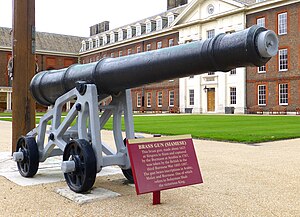Sultanate of Singora
The sultanate's history was documented in accounts, letters and journals written by British and Dutch East India Company traders; its destruction was discussed in books and reports authored by representatives of the French embassies to Siam in the mid 1680s.
Sources pertaining to the Singora cannon include articles published in academic journals and letters written by General Sir Harry Prendergast, commander of the Burma Expeditionary Force that captured Mandalay in the third Anglo-Burmese War.
[1] British and Dutch East India Company traders called the city Sangora; Japanese officials knew it as Shinichu; contemporary French writers used the names Singor, Cingor and Soncourat.
[10] A Cottonian manuscript at the British Library discusses Singora's duty-free policy and viability as a hub for regional trade: itt were not amiss to build a strong howse in Sangora which lyeth 24 Leagues northwarde of Patania, under the gouerment of Datoe Mogoll, vassall to the King of Siam: In this place maie well the Rendezvouz bee made to bring all thinges together that you shall gather for the provideing of the ffactories of Siam, Cochinchina, Borneo and partlie our ffactorie in Japan, as you shall gather according to the advises thereof, And hither to bring all such wares as wee shall gather from the foresaid places to bee sent to Bantam and Jaccatra: this howse willbee found to bee verie Necessarie, for the charges willbee too highe in Patania besides inconveniences there; which charges you shall spare at Sangora: there you pay no Custome, onlie a small gift to Datoe Mogoll cann effect all here.Dato Mogol died in 1620 and was succeeded by his eldest son, Sulaiman.
He stopped en route at Singora in February 1642 and presented Sulaiman with a letter of introduction from the Phra Khlang (known by the Dutch as the Berckelangh), the Siamese official responsible for foreign affairs.
Samuel Potts, a British East India Company trader based in Singora, recorded the city's preparations for war: This King has fortified his City, gunned his Forts upon the hills, making all the provision he can for his defence, not knowing how soon the King of Siam will oppose him.In a letter dated August 1679 Potts informed his East India Company colleague that the Siamese fleet had arrived and stressed the impending danger.
[26] Simon de la Loubère, France's envoy to Siam in 1687, recounted a story about a French cannoneer who crept into the city one night and single-handedly captured the sultan: Some have upon this account informed me a thing, which in my opinion, will appear most incredible.
He took him indeed, and brought him to the Siamese General, and so terminated a War of above twenty years.While Loubère's account of life in 17th-century Siam was well received by his contemporaries in France, the veracity of his tale about Cyprian and Singora's demise has been questioned.
[30] In 1685 Siam attempted to cede Singora to France: the hope was that the French East India Company, supported by a garrison of troops, could rebuild the city, establish a trading post and counter the strong regional Dutch influence.
[32] The French, however, were not interested: Secretary of State for the Navy, the Marquis de Seignelay, told Kosa Pan that Singora was ruined and of no further use, and asked for a trading post in Bangkok instead.
[35] Present-day descendants include Admiral Niphon Sirithorn, a former Commander-in-Chief of the Royal Thai Navy General Chavalit Yongchaiyudh, the 22nd Prime Minister of Thailand; and a family of silk weavers at the Muslim village of Phumriang in Surat Thani.
[38] In her book In the Land of Lady White Blood: Southern Thailand and the Meaning of History, Lorraine Gesick discussed a manuscript from Wat Pha Kho in Sathing Phra.
The manuscript (which in Gesick's opinion dates from the late 17th century) consists mainly of an illustrated map about ten metres long that depicts Sultan Sulaiman's forts at Khao Daeng.
[39] Located in a Muslim graveyard about 1 kilometre (0.62 mi) north of Khao Daeng, the tomb of Sultan Sulaiman Shah is housed in a small, Thai-style pavilion surrounded by large trees.
One inscription refers to the engraver, Tun Juma'at Abu Mandus of Singora; another is set within a circular arabesque design and reads "The seal of Sultan Sulaiman Shah, the Victorious King".




